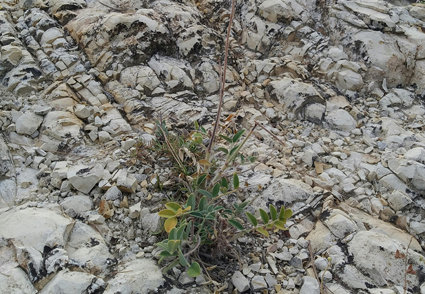Abstract
Long-term field surveys within Tunisian dorsal revealed the recollection of the poorly known North African endemic Onobrychis kabylica and O. conferta subsp. conferta. Two new varieties of O. conferta subsp. conferta are described and illustrated, a key to recognize the two varieties of the species and a distribution map of both taxa are included. IUCN Red List assessment shows that the species should be considered Critically Endangered and requires the implementation of immediate appropriate measurements to ensure their conservation.
References
- Abdelguerfi, A. & Laouar, M. (2002) Distribution des espèces d’Onobrychis en relation avec quelques facteurs du milieu, en Algérie. Annales de l’Institut National Agronomique El Harrach 23 (1 & 2).
- Abdessemed, K. (1988) Note sur les ressources phylogénétiques de l’Aurès et de Belezma. Annales de l’Institut National Agronomique El Harrach 12 (1): 70–78.
- Amirahmadi, A., Kazempour-Osaloo, Sh., Kaveh, A. Maassoumi, A.A. & Naderi, R. (2016) The phylogeny and new classification of the genus Onobrychis (Fabaceae-Hedysareae): evidence from molecular data. Plant Systematics and Evolution 302: 1445–1456. https://doi.org/10.1007/s00606-016-1343-1
- Bachman, S., Moat, J., Hill, A., de la Torre, J. & Scott, B. (2011) Supporting Red List threat assessments with GeoCAT: Geospatial conservation assessment tool. ZooKeys 150: 117–126. http://dx.doi.org/10.3897/zookeys.150.2109
- Battandier, J.A. & Trabut, L.C. (1889) Auteur du texte. Flore de l’Algérie. Ancienne “Flore d’Alger” transformée, contenant la description de toutes les plantes signalées jusqu’à ce jour comme spontanées en Algérie. pp. 292.
- Blanca, G., Cabezudo, B., Cueto, M., Salazar, C. & Morales Torres, C. (eds.) (2011) Flora Vascular de Andalucía Oriental. 2ª Edición corregida y aumentada. 1751 pp.
- Boissier, E. (1840) Voyage Botanique dans le Midi de l’Espagne 188.
- Cattaneo, C. & Grano, M. (2019) Checklist updating and analysis of the flora of Symi island and of the nearby island of Seskli (Dodecanese, Greece). Bocconea 28: 425–463.
- Collen, B., Dulvy, N.K., Gaston, K.J., Gärdenfors, U., Keith, D.A., Punt, A.E., Regan, H.M., Böhm, M., Hedges, S., Seddon, M., Butchart, S.H.M., Hilton-Taylor, C., Hoffmann, M., Bachman, S.P. & Akçakaya, H.R. (2016) Clarifying misconceptions of extinction risk assessment with the IUCN Red List. Biology Letters 12: 20150843. https://doi.org/10.1098/rsbl.2015.0843
- Fennane, M. (2018) Eléments pour un livre rouge de la flore vasculaire du Maroc. Fasc. 6. Fabaceae (version 1, avril 2018). Edit. Tela-Botanica.
- Güner, Ö. & Çetin, Ö. (2020) A Contribution to the Flora of the Region Between İnceburun (Kaş) and Çayağzı (Demre) (Antalya-Turkey). Afyon Kocatepe Üniversitesi Fen Ve Mühendislik Bilimleri Dergisi 20 (5): 768–782.
- IUCN Standards and Petitions Committee (2019) Guidelines for using the IUCN Red List categories and criteria. Version 14. Prepared by the IUCN SSC Standards and Petitions Committee. [http://www.iucnredlist.org/documents/RedListGuidelines.pdf]
- Kougioumoutzis, K., Tiniakou, A., Georgiadis, T. & Georgiou, O. (2012) Contribution to the flora of the South Aegean volcanic arc: the Methana Peninsula (Saronic Gulf, Greece). Edinburgh journal of botany 69 (1): 53–81.
- Le Floc’h, E., Boulos, L. & Véla, E. (2010) Catalogue synonymique commenté de la flore de Tunisie. 2nd edition. Ministère de l’Environnement et du Développement Durable, Tunis, pp. 500.
- Le Houérou, H.N. (1995) Bioclimatologie et biogéographie des steppes arides du Nord de l’Afrique : diversité biologique, développement durable et désertisation. In: Le Houérou, H.-N. (Ed.) Bioclimatologie et biogéographie des steppes arides du Nord de l’Afrique: diversité biologique, développement durable et désertisation. Montpellier: CIHEAM, 1995. pp. 1–396. [Options Méditerranéennes: Série B. Etudes et Recherches; n. 10]
- Lock, J.M. & Simpson, K. (1991) Legumes of West Asia, a check-list. Royal Botanic Gardens, Kew.
- Mabberley, D.J. (1997) The plant book. A portable dictionary of the vascular plants, 2nd ed. Cambridge University Press. Cambridge.
- Miller, P. (1754) Granadilla, Passion-flower. In: The Gardeners dictionary abridged, fourth edition. [The volumen has no page numbers] Available from: http://www.tropicos.org/Reference/100000805 (accessed 23 January 2017)
- Perrino, E.V. & Signorile, G. (2009) Costa di Monopoli (Puglia): check-list della flora vascolare. Informatore Botanico Italiano 41 (2): 263–279
- Perrino, E.V., Signorile, G. & Marvulli, M. (2013) A first checklist of the vascular flora of the Polignano a Mare coast (Apulia, southern Italy). Natura Croatica 22 (2): 295–318.
- Pomel, (1874) Bulletin de la Société des Sciences Physiques Algérie 11: 201.
- Pottier-Alapetite, G. (1979) Flore de la Tunisie: Angiospermes-Dicotylédones: Gamopétales. Publications Scientifiques Tunisiennes, Programme Flore et Végétation Tunisiennes, Première Partie.
- Quézel, P. & Santa, S. (1962) Nouvelle flore de l’Algérie et des régions désertiques méridionales. 2 tomes. Ed. C.N.R.S. Paris, pp. 1170.
- Rechinger, K.H. (1984) Onobrychis. In: Rechinger, K.H. (Ed.) Flora Iranica 157. Akademische Druck-u. Verlagsanstalt, Graz-Austria, pp. 387–464.
- Sakhraoui, A., Ltaeif, H.B., Castillo, J.M. & Rouz, S. (2024) Habitat characterization and decline of Critically Endangered Onobrychis conferta subsp. conferta. Journal for Nature Conservation 79: 126603. https://doi.org/10.1016/j.jnc.2024.126603
- Sakhraoui, A., Ltaeif, H.B., Sakhraoui, A., Rouz, S. & Castillo, J.M. (2023) Potential use of wild Onobrychis species for climate change mitigation and adaptation. Crop Science 63 (6): 3153–3174. http://dx.doi.org/10.1002/csc2.21088
- Širjaev, G. (1926) Onobrychis generis revisio critica. Vol. 76. Partes secunda et tertia. Spisy. Prír Fak Masarykovy University, pp. 71.
- Thiers, B. (ed.) (2023) [continuously updated] Index Herbariorum: A global directory of public herbaria and associated staff. New York Botanical Garden’s Virtual Herbarium. Available from: http://sweetgum.nybg.org/science/ih/ (accessed: 22 March 2023)
- Tison, J.-M. & de Foucault, B. [coord.] (2014) Flora Gallica. Flore de France. Biotope Éditions, Mèze, pp. 743.
- Yakovlev, G.P., Sytin, A.K. & Roskov, J.R. (1996) Legumes of Northern Eurasia, a check-list. Royal Botanic Gardens, Kew.
- Yudaputra, A., Fijridiyanto, I.A., Yuzammi, Ridho Witono, J., Astuti, I.P., Robiansyah, I., Hendrian, R., Hutabarat, P., Yuswandi, A.Y., Raharjo, P.D., Syartinilia & Cropper Jr, W.P. (2022) Habitat preferences, spatial distribution and current population status of endangered giant flower Amorphophallus titanum. Biodiversity and Conservation 31: 831–854. https://doi.org/10.1007/s10531-022-02366-0


